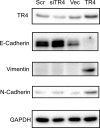TR4 nuclear receptor enhances prostate cancer initiation via altering the stem cell population and EMT signals in the PPARG-deleted prostate cells
- PMID: 25859557
- PMCID: PMC4381707
- DOI: 10.18632/oncoscience.121
TR4 nuclear receptor enhances prostate cancer initiation via altering the stem cell population and EMT signals in the PPARG-deleted prostate cells
Abstract
A recent report indicated that the TR4 nuclear receptor might suppress the prostate cancer (PCa) initiation via modulating the DNA damage/repair system. Knocking-out peroxisome proliferator-activated receptor gamma (PPARG), a nuclear receptor that shares similar ligands/activators with TR4, promoted PCa initiation. Here we found 9% of PCa patients have one allele of PPARG deletion. Results from in vitro cell lines and in vivo mouse model indicated that during PCa initiation TR4 roles might switch from suppressor to enhancer in prostate cells when PPARG was deleted or suppressed (by antagonist GW9662). Mechanism dissection found targeting TR4 in the absence of PPARG might alter the stem cell population and epithelial-mesenchymal transition (EMT) signals. Together, these results suggest that whether TR4 can enhance or suppress PCa initiation may depend on the availability of PPARG and future potential therapy via targeting PPARG to battle PPARG-related diseases may need to consider the potential side effects of TR4 switched roles during the PCa initiation.
Keywords: PPARG; Prostate cancer; TR4.
Figures






Similar articles
-
TR4 Nuclear Receptor Different Roles in Prostate Cancer Progression.Front Endocrinol (Lausanne). 2015 May 27;6:78. doi: 10.3389/fendo.2015.00078. eCollection 2015. Front Endocrinol (Lausanne). 2015. PMID: 26074876 Free PMC article. Review.
-
Differential roles of PPARγ vs TR4 in prostate cancer and metabolic diseases.Endocr Relat Cancer. 2014 Jun;21(3):R279-300. doi: 10.1530/ERC-13-0529. Epub 2014 Mar 12. Endocr Relat Cancer. 2014. PMID: 24623743 Review.
-
Increased chemosensitivity via targeting testicular nuclear receptor 4 (TR4)-Oct4-interleukin 1 receptor antagonist (IL1Ra) axis in prostate cancer CD133+ stem/progenitor cells to battle prostate cancer.J Biol Chem. 2013 Jun 7;288(23):16476-16483. doi: 10.1074/jbc.M112.448142. Epub 2013 Apr 22. J Biol Chem. 2013. PMID: 23609451 Free PMC article.
-
TR4 nuclear receptor functions as a tumor suppressor for prostate tumorigenesis via modulation of DNA damage/repair system.Carcinogenesis. 2014 Jun;35(6):1399-406. doi: 10.1093/carcin/bgu052. Epub 2014 Feb 28. Carcinogenesis. 2014. PMID: 24583925 Free PMC article.
-
Targeting TR4 nuclear receptor suppresses prostate cancer invasion via reduction of infiltrating macrophages with alteration of the TIMP-1/MMP2/MMP9 signals.Mol Cancer. 2015 Jan 27;14(1):16. doi: 10.1186/s12943-014-0281-1. Mol Cancer. 2015. PMID: 25623427 Free PMC article.
Cited by
-
Hepatocellular carcinoma: thyroid hormone promotes tumorigenicity through inducing cancer stem-like cell self-renewal.Sci Rep. 2016 May 12;6:25183. doi: 10.1038/srep25183. Sci Rep. 2016. PMID: 27174710 Free PMC article.
-
The Epithelial-Mesenchymal Transition at the Crossroads between Metabolism and Tumor Progression.Int J Mol Sci. 2022 Jan 12;23(2):800. doi: 10.3390/ijms23020800. Int J Mol Sci. 2022. PMID: 35054987 Free PMC article. Review.
-
Metabolic Reprogramming and Epithelial-Mesenchymal Plasticity: Opportunities and Challenges for Cancer Therapy.Front Oncol. 2020 May 20;10:792. doi: 10.3389/fonc.2020.00792. eCollection 2020. Front Oncol. 2020. PMID: 32509584 Free PMC article. Review.
-
TR4 Nuclear Receptor Different Roles in Prostate Cancer Progression.Front Endocrinol (Lausanne). 2015 May 27;6:78. doi: 10.3389/fendo.2015.00078. eCollection 2015. Front Endocrinol (Lausanne). 2015. PMID: 26074876 Free PMC article. Review.
-
Macrophage inflammatory factors promote epithelial-mesenchymal transition in breast cancer.Oncotarget. 2018 Mar 23;9(36):24272-24282. doi: 10.18632/oncotarget.24917. eCollection 2018 May 11. Oncotarget. 2018. PMID: 29849939 Free PMC article.
References
-
- Liu NC, Lin WJ, Kim E, Collins LL, Lin HY, Yu IC, et al. Loss of TR4 orphan nuclear receptor reduces phosphoenolpyruvate carboxykinase-mediated gluconeogenesis. Diabetes. 2007;56:2901–9. - PubMed
-
- Liu NC, Lin WJ, Yu IC, Lin HY, Liu S, Lee YF, et al. Activation of TR4 orphan nuclear receptor gene promoter by cAMP/PKA and C/EBP signaling. Endocrine. 2009;36:211–7. - PubMed
Grants and funding
LinkOut - more resources
Full Text Sources
Other Literature Sources

